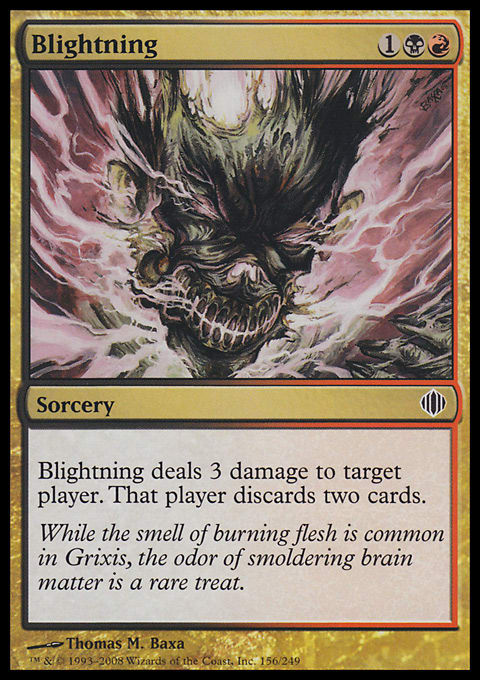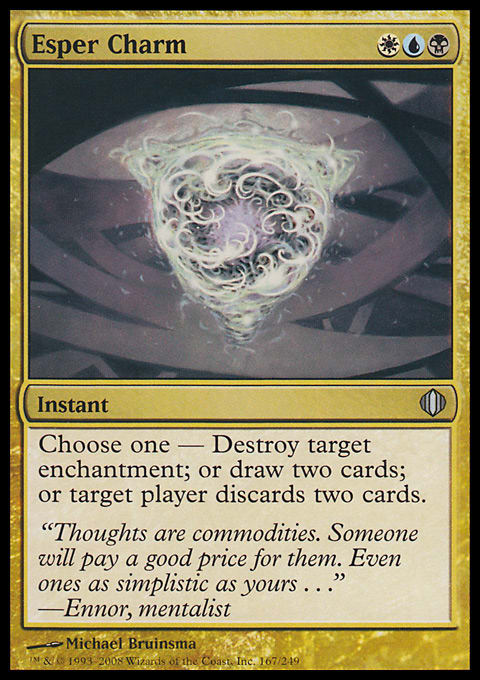Being written one day after Mythic Championship VI, one thing I could have done this week would be to write about the Mythic Championship VI decks. However there is a ban looming in approximately seven days so unless you have a PTQ coming up this week* most of the technology would age like milk. I assume 100 other people are writing about those decks anyway.
If you really want my hot take, I think Oko, Thief of Crowns (but none of the other super popular cards like Once Upon a Time and Gilded Goose, both of which were more heavily played than Oko at Mythic Championship VI) will be banned in Standard.
That said, I think that sometime in the next 365 days, Once Upon a Time will be banned in Pioneer, but not Oko, Thief of Crowns. Which is weird, right? But that's what I think will happen.
If you still really really want to hear about the current Standard, here is the deck my friend Roman Fusco played to a Top 50 finish at the Grand Prix in Richmond yesterday:
U/W Control | Eldraine Standard | Roman Fusco
- Creatures (6)
- 1 Agent of Treachery
- 1 Gadwick, the Wizened
- 4 Brazen Borrower
- Planeswalkers (4)
- 4 Teferi, Time Raveler
- Instants (13)
- 1 Aether Gust
- 1 Mystical Dispute
- 1 Tale's End
- 2 Dovin's Veto
- 4 Absorb
- 4 Chemister's Insight
- Sorceries (7)
- 1 Planar Cleansing
- 2 Mass Manipulation
- 4 Time Wipe
- Enchantments (3)
- 3 Prison Realm
- Lands (27)
- 5 Plains
- 8 Island
- 2 Castle Ardenvale
- 2 Hallowed Fountain
- 3 Castle Vantress
- 3 Fabled Passage
- 4 Tranquil Cove
Going into Saturday, Roman, who was staying in a house of ten other Los Angeles-based Californian Magic: The Gathering players, was largely encouraged (predictably) to run a Simic deck of some sort. Only PT competitor Justin Porchas helped him with his ![]()
![]() 75. He in fact ended up with the best GP finish in the house, even defeating three housemates in the tournament, himself!
75. He in fact ended up with the best GP finish in the house, even defeating three housemates in the tournament, himself!
Which is to say that you don't have to play an Oko, Thief of Crowns deck to perform in Standard right now (that is, pre-impending bans). Most of the outlier draws in Standard involve turning all your lands into 3/3 Elementals, so any kind of a Time Wipe is not only a Wrath of God, but a de facto Armageddon.
Cute, huh?
That said, in the actual Mythic Championship, the highest performing Azorius Control deck finished something like five wins in the Swiss, whereas the highest eight performing Once Upon a Time decks were one, two, three, four, five, six, seven, and... you guessed it, eight.
Given how likely the world will change before I greet you in this column again, I decided to write not about a dwindling Standard that seemingly nobody likes, but rather my favorite one of all time. No, this is probably not productive to you in terms of learning anything about the current legal sets or available decks... But my point is nothing else I could write would be very durable either. At least I loved this deck.
Anyway, here it is:
Mono-Cascade, aka "Black Baneslayer Cascade Control" | M10 Standard | Michael Flores
- Creatures (13)
- 1 Enigma Sphinx
- 4 Baneslayer Angel
- 4 Bloodbraid Elf
- 4 Enlisted Wurm
- Instants (8)
- 4 Bituminous Blast
- 4 Esper Charm
- Sorceries (12)
- 4 Blightning
- 4 Captured Sunlight
- 4 Deny Reality
- Lands (27)
- 1 Forest
- 1 Island
- 1 Mountain
- 1 Swamp
- 2 Plains
- 1 Vivid Grove
- 2 Vivid Creek
- 2 Vivid Marsh
- 4 Exotic Orchard
- 4 Reflecting Pool
- 4 Vivid Crag
- 4 Vivid Meadow
- Sideboard (15)
- 3 Ajani Vengeant
- 4 Hallowed Burial
- 4 Maelstrom Pulse
- 4 Primal Command
I recovered this list from my old blog, FiveWithFlores.com!
I considered this build an upgrade to my previous version, which played four copies of Borderland Ranger and Lightning Bolt.
Interestingly, this was from about the same Standard era as Naya Lightsaber, a World Championship-winning deck I designed that Frank Karsten once called one of the seven worst decks ever to win a Pro Tour. You'll note that, like Naya Lightsaber, Mono-Cascade also didn't play Jungle Shrine, despite needing Green, Red, and White also.
Speaking of no Jungle Shrine...
The Mono-Cascade strategy used every part of the deck design buffalo. There are exactly fourteen lands that enter the battlefield untapped (including every kind of basic land, a concession to Path to Exile). Like many of my tricks, I learned that one from the masterful Patrick Chapin. The secret to making this deck work is the interplay between the many Vivid lands (and Exotic Orchard, another land that managed to enter the battlefield untapped) and Reflecting Pool. You could basically cast anything with this mana base!
It had the odd distinction of playing 27/60 lands, many of which tapped for every color, and was nevertheless sometimes unable to actually cast anything by turn five. You might also notice that there isn't a single card in the deck that costs less than three mana.
Sounds absolutely miserable, right? Why would anyone subject themselves to playing this, let alone say it were their favorite deck of all time?
No, the deck didn't actually play the card Cruel Ultimatum, though that card was legal, and if you squinted really hard you would probably make it work. The deck was exciting because everything was Cruel Ultimatum!
The weakest play in the deck was the equivalent of making the opponent take three damage (or back then, braining a Planeswalker for three) and forcing them to discard two cards; or some variation of Esper Charm... Drawing, forcing discard, or in a pinch getting rid of a troublesome permanent like Bitterblossom or Pyromancer Ascension. The deck had a plan and the outcome of anything and everything you did was utterly predictable.
Almost everything ended up "there"!
So unlike Naya Lightsaber, which sometimes accidentally turned over a target-less Path to Exile with an ambitious 4-drop, your Bloodbraid berserkers almost always forced the opponent to discard their hand before they even resolved. If they didn't it was just because you wanted to do something else. Everything you drew from then on - every single kind of card but one - resulted in forcing the opponent to discard two, or worse. Captured Sunlight was "gain four life and draw two cards" for four mana. Bituminous Blast made five mana look like seven, or maybe even nine.
Deny Reality was so wild. The bad ones set the opponent behind on the battlefield while tearing up their hands, and the filthy ones smashed them helpless for three - or even six - the same turn.
And ultimately, there was Enlisted Wurm!
The terrible Enlisted Wurms made two 5/5 creatures for six mana. Which is bigger and better than any Broodmate Dragon for a similar cost... Especially when one of them was also flying, first strike, so on, and so forth. Enlisted Wurm into Baneslayer Angel was literally the only way the deck could "whiff" ... and that concession was by design. Back then, before the pestilential proliferation of Primeval Titans, Baneslayer Angel was still the best and most powerful large creature "of all time", and more importantly, would help you catch up against the rare fast strategies that might otherwise punish someone with no plays on turns one, two, or sometimes even three.
The really lavish Enlisted Wurms...
- Made a 5/5,
- Killed (or at least bounced) the opponent's best creature,
- Gained four life, and
- Drew two cards to help you do it all again next turn!
This deck never "hit"-hit in paper Magic.
It was from a weird period when mid-range was incredibly popular. On par with November 2019 philosophically. Jund was far and away the most prevalent strategy; with Naya Lightsaber a kind of one-tournament solution that, while successful in bisecting the villainous Sith Lord, neglected to behead it (never anticipating a resurgence in robot parts and iconic breathing apparatus). People played s l o w decks. There was long discussion about whether Putrid Leech or Rampant Growth was better at the two; and creatures were so card advantageous - either generating twin Dragons or drawing cards while paying for them - that running any removal outside of Bituminous Blast might be controversial.
Almost no one played Mono-Cascade, at least in Standard.
It's from an era where I played a lot of MTGO and I just got bored. I made Naya Lightsaber one night because I was riffing on a Nissa Revane** deck that Evan Erwin posted; until I realized you could just accomplish all the same stuff, eventually, while playing better and more straightforward cards. You win - or your friend, wins, in this case - one World Championship and that stuff gets boring though.
You largely had time to develop. Not playing a creature on turn two (or three) didn't necessarily doom you. It's not that people didn't play beatdown decks... But there was a window where they were relatively infrequent. Even when they were swinging with Goblin Guides (not yet popular, if you can believe that), the Red Decks were fueling your ability to eventually line up your Baneslayer Angel, which would almost always result in a comeback if you were able to untap with it.
Today's Standard reminds me of this weirdo world, but probably even more pronounced. People make flashy plays on turn two - Gilded Goose in to Oko, Thief of Crowns, say - but the game doesn't really end there. Both of you kind of do stuff in each other's directions for another ten turns, before the game actually ends. It's downright civil.
Back then, the same kind of Jund-space gave us time to hit lands and develop our games. The Cascade mechanic kind of auto-beat the entire color Blue. They might have Cancel (Cancel if you can believe that!) but it wasn't even that they couldn't Cancel everything... They couldn't Cancel multiple cards in a Cascade sequence, so something was getting through. Until, you know, their hand got blown up anyway. Beautiful in its way. Utterly predictable. But un-civil; a deck viable only because there was so much Jund no one was holding it to task with 1-drops into Cavalcade of Calamity (or the temporal equivalent).
If there's a "today" lesson from my favorite deck, it's that right now you probably have an opportunity to get much, much bigger than the current Simic-adjacent decks. Their central game plans mostly work because everyone agrees that Oko, Thief of Crowns is central to the field of battle. Decks like Roman's (above) that largely ignore Food tokens and Elk can avoid "losing" on turn two or three, and then actually catch up with cards like Time Wipe and card drawing later.
Here's to a whole new world next week.
LOVE
MIKE
*Ironically, I in fact, have such a PTQ this weekend.
**Nissa sure has come a long way, right?


























